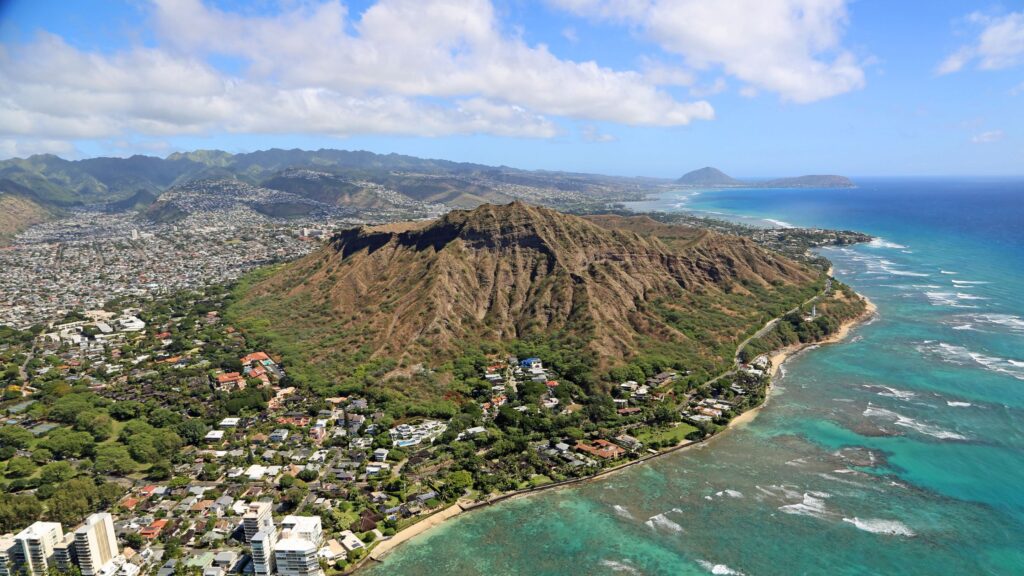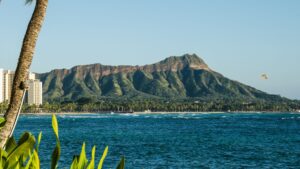Often referred to as “The Gathering Place,” Oahu boasts a rich tapestry of culture, stunning landscapes, and an intriguing geological history. A question we frequently hear from new visitors is, “Does Oahu have active volcanoes?”
To provide a comprehensive answer, let’s delve deeper into Oahu’s volcanic past and impact.
Geological Background
Before addressing Oahu’s specific volcanic history, it’s important to appreciate and understand the broader context of Hawaii’s geology.
The Hawaiian Islands, including Oahu, are a result of a geological phenomenon known as a “hot spot.” This hot spot—a plume of molten rock—beneath the Earth’s crust. As the Pacific Plate slowly moved over this hot spot, it created a chain of volcanic islands, with the oldest to the northwest, Kauai, and the youngest to the southeast, The Big Island of Hawaii.
Oahu’s Volcanic History
Oahu’s geological narrative unfolds millions of years in the past, differentiating it from its volcanic neighbors, such as the Big Island, which is still home to active volcanoes like Kilauea and Mauna Loa.
Approximately two to three million years ago, Oahu witnessed its most robust period of volcanic activity. During this epoch, two colossal shield volcanoes, Waianae and Koolau, etched the island’s contours. These volcanic giants erupted repeatedly, blanketing the island with layers of basaltic lava flows, giving birth to Oahu’s unique topography.
Oahu’s Dormant Volcanoes
Fast forward to today, and Oahu stands as a testament to geological dormancy. It has been hundreds of thousands of years since the island experienced a volcanic eruption. This dormancy sets Oahu apart from its contemporaries, making it a land without active volcanoes in the present day.
Unlike the Big Island, where volcanic activity is a living, breathing entity, Oahu’s volcanic fervor is part of a distant past.
Diamond Head: The Dormant Monument

While Oahu may lack active volcanoes, it does possess a prominent reminder of its volcanic past in the form of Diamond Head, or “Leahi” in Hawaiian. Though often misidentified as a volcano, Diamond Head is, in reality, a dormant volcanic crater. Its last eruption occurred over 150,000 years ago. Today, it stands as an iconic symbol of Oahu and a favored hiking destination, offering panoramic vistas of the island’s diverse landscapes and stunning coastline.
Significance and Impact
Understanding Oahu’s volcanic history is not merely an academic exercise; it holds cultural, environmental, and geological significance. The island’s unique geology has played a crucial role in shaping its landscapes, influencing ecosystems, and fostering a deep connection between its people and the land.
Oahu’s lack of active volcanoes contributes to its appeal as a tourist destination. Visitors can explore its lush rain forests, pristine beaches, and vibrant cities without the apprehension of encountering volcanic eruptions. This distinguishing feature of Oahu, alongside its rich culture and history, offers an exceptional travel experience.
Conclusion
Oahu, “The Gathering Place,” does not currently have any active volcanoes. While Diamond Head serves as a lasting reminder of Oahu’s volcanic heritage, the island remains dormant in terms of volcanic activity.
Oahu’s story is a testament to the dynamic geological processes that have shaped the Hawaiian Islands, and it underscores the island’s unique position in the Pacific.
So, when you step foot on Oahu, you can embrace the island’s natural beauty, immerse yourself in its vibrant culture, and explore its rich history—all without the need to keep an eye on the horizon for signs of volcanic eruptions.
Oahu may not have active volcanoes, but it has an abundance of aloha waiting to be discovered.


 HawaiianMiles Review: Hawaiian Airlines Frequent Flyer Program
HawaiianMiles Review: Hawaiian Airlines Frequent Flyer Program